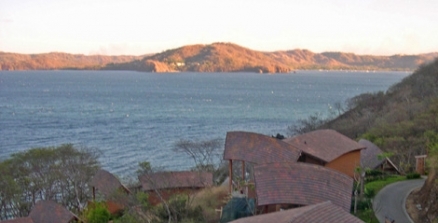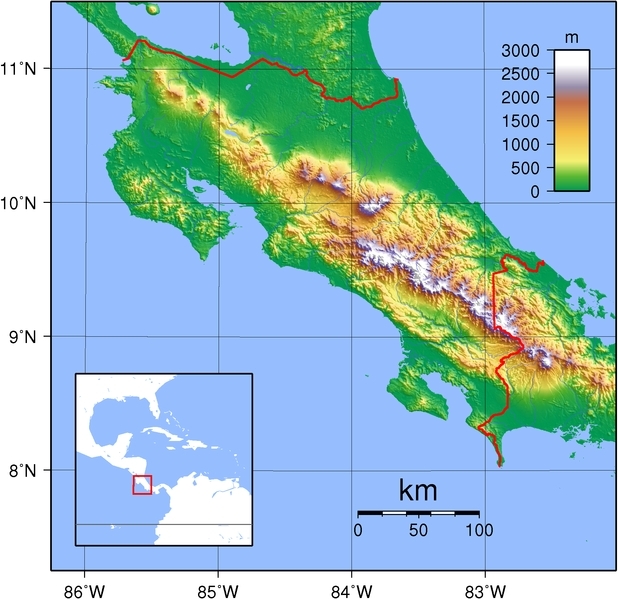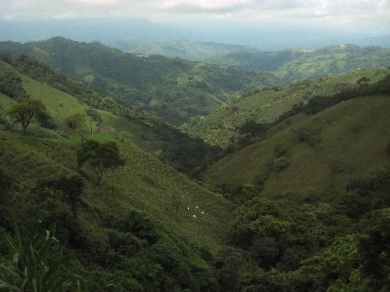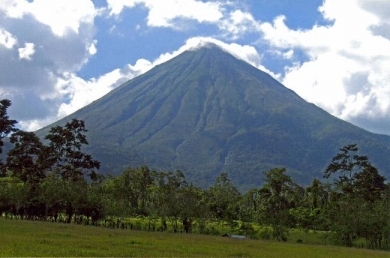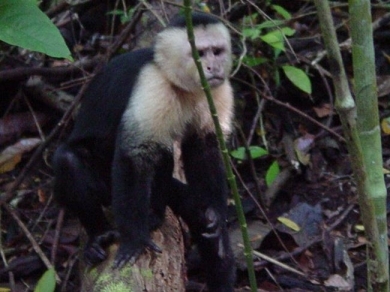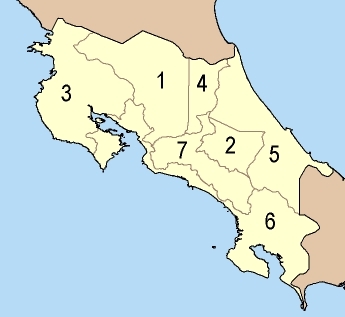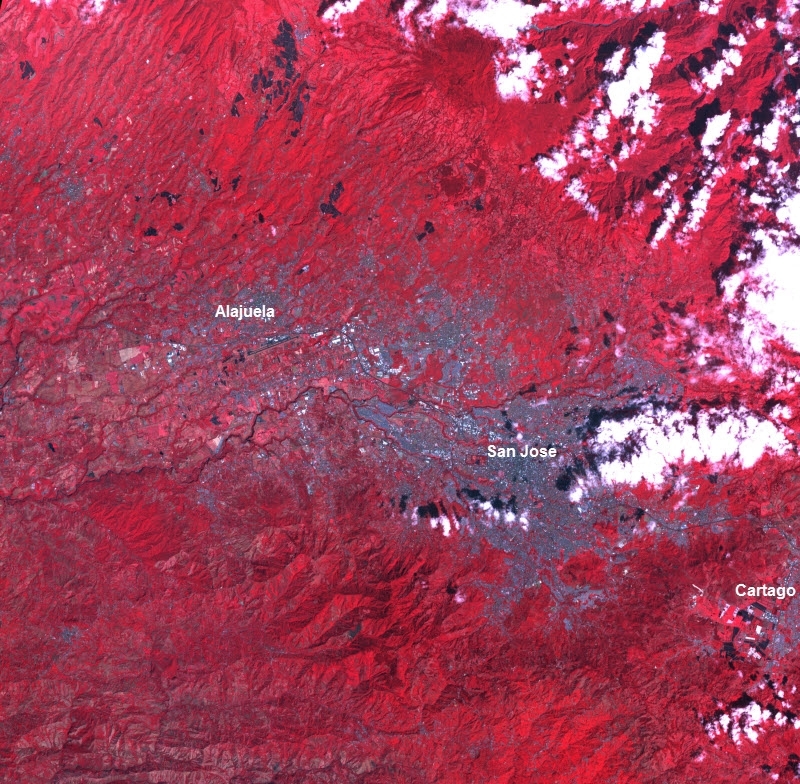Costa Rica
Countries and Regions of the World Collection  Costa Rica is a Central American nation lof four-and-a-half million people ocated between Nicaragua to the north and Panama to the south. Its eastern coast fronts the Caribbean Sea while its western coast fronts the Pacific Ocean.
Costa Rica is a Central American nation lof four-and-a-half million people ocated between Nicaragua to the north and Panama to the south. Its eastern coast fronts the Caribbean Sea while its western coast fronts the Pacific Ocean.
Its main environmental issues include:
- deforestation and land use change, largely a result of the clearing of land for cattle ranching and agriculture;
- soil erosion;
- overfishing leading to coral reef damage;
- coastal marine pollution;
- fisheries protection;
- solid waste management; and
- air pollution.
It is also susceptible to occasional earthquakes, hurricanes along Atlantic coast; frequent flooding of lowlands at onset of rainy season and landslides; and, active volcanoes.
Four volcanoes, two of them active, rise near the capital of San Jose in the center of the country. One of the volcanoes, Irazu, erupted destructively in 1963-65.
Although explored by the Spanish early in the 16th century, initial attempts at colonizing Costa Rica proved unsuccessful due to a combination of factors, including: disease from mosquito-infested swamps, brutal heat, resistance by natives, and pirate raids.
It was not until 1563 that a permanent settlement of Cartago was established in the cooler, fertile central highlands. The area remained a colony for some two and a half centuries.
In 1821, Costa Rica became one of several Central American provinces that jointly declared their independence from Spain.
Two years later it joined the United Provinces of Central America, but this federation disintegrated in 1838, at which time Costa Rica proclaimed its sovereignty and independence.
Since the late 19th century, only two brief periods of violence have marred the country's democratic development.
Although it still maintains a large agricultural sector, Costa Rica has expanded its economy to include strong technology and tourism industries.
The standard of living is relatively high. Land ownership is widespread.
While the traditional agricultural exports of bananas, coffee, sugar, and beef are still the backbone of commodity export trade, a variety of industrial and specialized agricultural products have broadened export trade in recent years.
High value added goods and services, including microchips, have further bolstered exports.
Tourism continues to bring in foreign exchange, as Costa Rica's impressive biodiversity makes it a key destination for ecotourism.
Contents
Geography
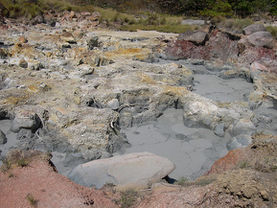 Volcanic mud pools, northern Costa Rica. @ C.Michael Hogan Location: Central America, bordering both the Caribbean Sea and the North Pacific Ocean, between Nicaragua and Panama (Ecoregions of Panama)
Volcanic mud pools, northern Costa Rica. @ C.Michael Hogan Location: Central America, bordering both the Caribbean Sea and the North Pacific Ocean, between Nicaragua and Panama (Ecoregions of Panama)
Geographic Coordinates:10 00 N, 84 00 W
Area: 51,100 sq km (50,660 sq km land and 440 sq km water). This includes Isla del Coco 550 km off the Pacific Coast of the main land.
Coastline: 1290 km
Maritime Claims:
territorial sea: 12 nm
exclusive economic zone: 200 nm
continental shelf: 200 nm
Natural Hazards: Occasional earthquakes, hurricanes along Atlantic coast; frequent flooding of lowlands at onset of rainy season and landslides; active volcanoes.
Volcanism: Arenal (elev. 1,670 m), which erupted in 2010, is the most active volcano in Costa Rica. A 1968 eruption destroyed the town of Tabacon. Irazu (elev. 3,432 m), situated just east of San Jose, has the potential to spew ash over the capital city as it did between 1963 and 1965. Other historically active volcanoes include Miravalles, Poas, Rincon de la Vieja, and Turrialba.
A magnitude 6.1 earthquake caused at least 20 deaths in Costa Rica on January 8, 2009, according to the U.S. Geological Survey (USGS). The earthquake was centered 30 kilometers north of San Jose (the country’s capital) and just 4.5 kilometers (2.8 miles) below the surface, a depth shallow enough to ensure strong shaking at the surface. The quake damaged buildings and sent earth tumbling in the mountainous Central American country. Landslides caused the majority of the deaths, said the USGS.
Costa Rica is prone to geologic hazards. Active volcanoes dot the small country, and faults, both active and ancient, weave through the country. The January 8 earthquake was centered near two very active volcanoes, Poás and Irazú. Further evidence of geologic activity lies in the high mountain range, the Cordillera de Talamanca, that runs parallel to the coast.
All of this geologic activity, the January 8 earthquake included, can be attributed to plate tectonics. The Cocos plate, a small portion of Earth’s surface beneath part of the eastern Pacific Ocean, is slipping beneath the portion of Earth’s surface that includes Costa Rica, the Caribbean plate. As the Cocos plate moves under the Caribbean plate at a rate of about 75 millimeters per year, it exerts pressure on the Caribbean plate. That pressure formed the mountains and the volcanoes. To ease the pressure, the earth near the edge of the plate shifts from time to time along weak points or faults. The January 8 earthquake did not occur along any known fault, but was caused by the build up of pressure from the subduction of the Cocos plate under the Caribbean plate, said the USGS. (Source: NASA/Holli Riebeek.)
Terrain: Topography includes [[coast]al] plains separated by rugged mountains including over 100 volcanic cones, of which several are major volcanoes.
Climate: Tropical and subtropical; dry season (December to April); rainy season (May to November); cooler in highlands.
Tography of Costa Rica. Source: Wikimedia Commons.
Ecology and Biodiversity
Costa Rica is home to a rich variety of plants and animals. While the country has only about 0.1% of the world's landmass, it contains five percent of the world's biodiversity. All of Costa Rica is included in the subtropical and tropical Mesoamerica Biodiversity Hotspot. The coral reefs of Costa Rica suffer from overfishing as the primary threat to their degradation. (Rodríguez-Ramírez et al, 2004)
Costa Rica has seven ecoregions that occur entirely or partly within its borders:
- Central American dry forests
- Southern Mesoamerican Pacific mangroves (Moist Pacific Coast mangroves and Southern Dry Pacific Coast mangroves)
- Mesoamerican Gulf-Caribbean mangroves (Rio Negro-Rio San Sun mangroves)
- Costa Rican seasonal moist forests
- Talamancan montane forests
- Isthmian-Atlantic moist forests
- Isthmian-Pacific moist forests
See also: Cocos Island moist forests
Protected Areas
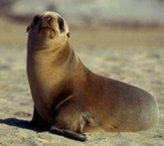 The California sea lion (Zalophus californianus) is a common marine mammal on the Isla del Coco. (Source: National Marine Fisheries Service)
The California sea lion (Zalophus californianus) is a common marine mammal on the Isla del Coco. (Source: National Marine Fisheries Service) Around 25% of the country's land area is in protected national parks and protected areas, the largest percentile of protected areas in the world.
Located in northwestern Costa Rica, the Area de Conservación Guanacaste's boundaries start 12 miles out into the Pacific Ocean and extend inland across the Pacific coastal lowlands, over three tall volcanoes and down into the Atlantic coastal lowlands. The total area of the Area de Conservación Guanacaste (ACG) (as of 2004) comprises 147,000 hectares (ha), comprising 104,000 terrestrial habitats and 43,000 marine habitats. The dry forest of the Guanacaste region are home to significant numbers of endemic species.
The Isla del Coco Marine and Terrestrial Conservation Area includes the entire Isla del Coco and the marine ecosystems up to a distance of 15 kilometers around the island. Isla del Coco is located 555 km southwest off the Pacific coast of Costa Rica, almost to the Galápagos Archipelago.
People and Society
Population: 4,636,348 (July 2012 est.)
Unlike many of their Central American neighbors, present-day Costa Ricans are largely of European rather than mestizo descent; Spain was the primary country of origin. However, an estimated 10% to 15% of the population is Nicaraguan, of fairly recent arrival and primarily of mestizo origin. Descendants of 19th-century Jamaican immigrant workers constitute an English-speaking minority, about 3% of the population. Few of the native Indians survived European contact; the indigenous population today is less than 1% of the population.
Ethnic groups: white (including mestizo) 94%, black 3%, Amerindian 1%, Chinese 1%, other 1%
| Mist rising over the rainforest near Gulfito on the Pacific coast near the border of Panama. This region is one of the wettest spots in the world. |
| Mountainous countryside along the road to the capital of San Jose. |
| Located in the central part of the country, Arenal Volcano remains active, treating visitors to steady rumbles and displays of fire from its cone. |
| A monkey in Manuel Antonio National Park. |
Age Structure:
0-14 years: 24.6% (male 574,876/female 549,664)
15-64 years: 69.1% (male 1,588,940/female 1,571,573)
65 years and over: 6.4% (male 135,017/female 156,492) (2011 est.)
Population Growth Rate: 1.288% (2012 est.)
Birth Rate: 16.4 births/1,000 population (2012 est.)
Death Rate: 4.38 deaths/1,000 population (July 2012 est.)
Net Migration Rate: 0.86 migrant(s)/1,000 population (2012 est.)
Life Expectancy at Birth: 77.89 years
male: 75.26 years
female: 80.65 years (2012 est.)
Total Fertility Rate: 1.92 children born/woman (2012 est.)
Languages: Spanish (official), English
Literacy: 94.9%
Urbanization: 64% of total population (2010) growing at an annual rate of change of 2.1% (2010-15 est.)
History
In 1502, on his fourth and last voyage to the New World, Christopher Columbus made the first European landfall in the area. Settlement of Costa Rica began in 1522. For nearly 3 centuries, Spain administered the region as part of the Captaincy General of Guatemala under a military governor. The Spanish optimistically called the country "Rich Coast." Finding little gold or other valuable minerals in Costa Rica, however, the Spanish turned to agriculture.
The small landowners' relative poverty, the lack of a large indigenous labor force, the population's ethnic and linguistic homogeneity, and Costa Rica's isolation from the Spanish colonial centers in Mexico and the Andes all contributed to the development of an autonomous and individualistic agrarian society. An egalitarian tradition also arose. This tradition survived the widened class distinctions brought on by the 19th-century introduction of banana and coffee cultivation and consequent accumulations of local wealth.
Costa Rica joined other Central American provinces in 1821 in a joint declaration of independence from Spain. Although the newly independent provinces formed a Federation, border disputes broke out among them, adding to the region's turbulent history and conditions. Costa Rica's northern Guanacaste Province was annexed from Nicaragua in one such regional dispute. In 1838, long after the Central American Federation ceased to function in practice, Costa Rica formally withdrew and proclaimed itself sovereign.
An era of peaceful democracy in Costa Rica began in 1899 with elections considered the first truly free and honest ones in the country's history. This began a trend that continued until today with only two lapses: in 1917-19, Federico Tinoco ruled as a dictator, and, in 1948, Jose Figueres led an armed uprising in the wake of a disputed presidential election.
With more than 2,000 dead, the 44-day civil war resulting from this uprising was the bloodiest event in 20th-century Costa Rican history, but the victorious junta drafted a constitution guaranteeing free elections with universal suffrage and the abolition of the military. In 1949, Costa Rica dissolved its armed forces and Figueres became a national hero. He won the first election under the new constitution in 1953. Since then, Costa Rica has held 15 presidential elections, the latest in 2010.
Costa Rica is an active member of the international community and proclaimed its permanent neutrality in 1993. Its record on the environment and human rights and advocacy of peaceful settlement of disputes give it a weight in world affairs far beyond its size. The country lobbied aggressively for the establishment of the UN High Commissioner for Human Rights and became the first nation to recognize the jurisdiction of the Inter-American Human Rights Court, based in San Jose. Costa Rica has been a strong proponent of regional arms limitation agreements. In 2009, Costa Rica completed its third term as a non-permanent member of the United Nations Security Council.
During the tumultuous 1980s, then-President Oscar Arias authored a regional peace plan that served as the basis for the Esquipulas Peace Agreement. Arias' efforts earned him the 1987 Nobel Peace Prize. Subsequent agreements, supported by the United States, led to the Nicaraguan election of 1990 and the end of civil war in Nicaragua. Costa Rica also hosted several rounds of negotiations between the Salvadoran Government and the Farabundo Marti National Liberation Front (FMLN), aiding El Salvador's efforts to emerge from civil war and culminating in that country's 1994 free and fair elections.
In 2007 Costa Rica established diplomatic ties with China, ending nearly 60 years of diplomatic relations with Taiwan. In 2008, Costa Rica established diplomatic relations with "The State of Palestine," and in 2009 Costa Rica reopened formal relations with Cuba. In 2009, then-President Arias acted as mediator in the Honduran constitutional crisis, working closely with ousted President Manuel Zelaya and the interim Honduran government. Costa Rica formally recognized Porfirio "Pepe" Lobo as the winner of the 2009 Honduran elections and the President of Honduras.
Costa Rica and Nicaragua have disputed issues related to their border for over a century. The latest flare-up began in October 2010 when Costa Rica claimed that, as part of an ongoing dredging operation, Nicaraguan troops crossed the Rio San Juan into Costa Rican territory. In March 2011, the International Court of Justice (ICJ) ruled on the provisional measures (similar to an injunction) requested by Costa Rica in its territorial dispute with Nicaragua. The Court’s final ruling on the dispute may take several years. While tensions between the two countries have eased somewhat, Nicaragua filed a counterclaim with the ICJ in December 2011 arguing a Costa Rican road construction project along the San Juan violates Nicaraguan sovereignty and is causing major environmental damage to Nicaraguan territory.
On May 8, 2010 Laura Chinchilla, of the National Liberation Party (PLN), was sworn in as President of the Republic of Costa Rica. Chinchilla’s top priority is strengthening security. She has pushed for fiscal reform to support her policies, seeking to boost revenue, possibly through revised tax legislation, to fund an increase in security services and education. Chinchilla is also focused on improving the country’s infrastructure, reforming taxes, expanding jobs through a “green jobs” initiative, creating better living conditions for children and senior citizens, and supporting women’s issues. Following the 2010 elections, the 57-member unicameral Legislative Assembly fragmented into several parties, with no faction having a plurality--the PLN won 23 seats, the PAC 12 seats, PML 9 seats, and the PUSC 6 seats, with the remaining seats split among lesser known parties.
Government
Costa Rica is a democratic republic with a very strong system of constitutional checks and balances. Executive responsibilities are vested in a president, who is the country's center of power. There also are two vice presidents and a 20-plus member cabinet. The president and 57 Legislative Assembly deputies are elected for 4-year terms. In April 2003, the Costa Rican Constitutional Court annulled a 1969 constitutional reform which had barred presidents from running for reelection. As a result, the law reverted back to the 1949 Constitution, which permits ex-presidents to run for reelection after they have been out of office for two presidential terms, or 8 years. Deputies may run for reelection after sitting out one term, or 4 years.
The electoral process is supervised by an independent Supreme Electoral Tribunal--a commission of three principal magistrates and six alternates selected by the Supreme Court of Justice. The last national elections took place in February 2010.
The offices of the Comptroller General of the Republic, the Solicitor General, and the Ombudsman exercise oversight of the government. The Comptroller General's office has a statutory responsibility to scrutinize all but the smallest public sector contracts and strictly enforces procedural requirements. Along with the Sala IV, these institutions are playing an increasingly prominent role in governing Costa Rica.
There are provincial boundaries for administrative purposes, but no elected provincial officials. Costa Rica held its first mayoral elections in December 2002, whereby mayors were elected to 4-year terms by popular vote through general elections. Prior to 2002, the office of mayor did not exist, and the president of each municipal council was responsible for the administration of his/her municipality. The most recent nationwide mayoral elections took place in December 2010.
Costa Rica has no military and maintains only domestic police and security forces. A professional Coast Guard was established in 2000.
|
Government Type: Democratic republic Capital: San Jose - 1.416 million (2009) Administrative divisions: 7 provinces (provincias, singular - provincia);
Independence Date: 15 September 1821 (from Spain) Legal System: civil law system based on Spanish civil code. Judicial power is exercised by the Supreme Court of Justice, composed of 22 magistrates selected for renewable 8-year terms by the Legislative Assembly, and subsidiary courts. A Constitutional Chamber of the Supreme Court (Sala IV), established in 1989, reviews the constitutionality of legislation and executive decrees and all habeas corpus warrants.Costa Ricaaccepts compulsory International Court of Justice (ICJ) jurisdiction; and accepts International criminal court (ICCt) jurisdiction. |
Source: Wikimedia Commons |
Costa Rica has long emphasized the development of democracy and respect for human rights. The country's political system has steadily developed, maintaining democratic institutions and an orderly, constitutional scheme for government succession. Several factors have contributed to this trend, including enlightened leadership, comparative prosperity, flexible class lines, educational opportunities that have created a stable middle class, and high social indicators. Also, because Costa Rica has no armed forces, it has avoided military involvement in political affairs, unlike other countries in the region.
San José, capital city of Costa Rica, fills the valley between two steep mountain ranges. In this image made from data collected by the Advanced Spaceborne Thermal Emission and Reflection Radiometer (ASTER) instrument on NASA’s Terra satellite, visible, shortwave, and near-infrared wavelengths of light that the sensor observed have been combined to produce a false-color version of the scene in which vegetation is red, urban areas are silvery gray, water is dark blue, and clouds are white. The image was captured on February 8, 2007.
San José is in the center of the image. The Rio Torres winds through downtown San José. Cartago, the much smaller colonial capital, sits in the lower right corner, while the city of Alajuela appears across the river, northwest of San José. The cities’ manmade surfaces contrast sharply with the lushly vegetated landscape surrounding the city. Greenhouses are common in the region, and their glass roofs may be the brilliant white spots around the outer edges the cities. The long, straight runway of the Tobias Bolanos International Airport is visible as a dark line southeast of Alajuela.
The landscape around the two cities shown here is rugged. Steep mountain peaks cast dark shadows across their leeward slopes. Patches of dark red vegetation on the mountains north of San José may be rainforest. Coffee plantations also cover the slopes of the mountains around the city. February is the dry season in Costa Rica. During the rainy season, from about April to November, clouds usually block the satellite’s view of this tropical location. Source: NASA.
International Environmental Agreements
Costa Rica is party to international agreements on Biodiversity, Climate Change, Climate Change-Kyoto Protocol, Desertification, Endangered Species, Environmental Modification, Hazardous Wastes, Law of the Sea, Marine Dumping, Ozone Layer Protection, Wetlands, and Whaling.
Economy
After experiencing positive growth over the previous several years, the Costa Rican economy shrank slightly in 2009 (-2.5%) due to the global economic crisis. The services sector was the most affected, with tourism falling by 8%. Services account for nearly 70% of GDP. The economy experienced a rebound in 2010, with a 4.2% and 4.0% GDP growth rate in 2010 and 2011 respectively. Costa Rica enjoys the region’s highest standard of living, with purchasing power parity per capita income of about U.S. $11,500. The unemployment rate is 6.5%. Consumer price inflation has historically been high at about a 10% annual rate in the last decade, but since 2009 the rate has stayed in the 4% to 6% range.
Costa Rica's major economic resources are its fertile land and frequent rainfall, its well-educated population, and its location in the Central American isthmus, which provides easy access to North and South American markets and direct ocean access to the European and Asian continents. Costa Rica is known worldwide for its conservation efforts with more than 26% of its land under protection, thus safeguarding more than 5% of the entire world's biodiversity. The country's top economic priorities include passing fiscal reform, pursuing responsible monetary policy, and creating opportunities for inclusive economic growth. Significant legislative hurdles slow down passage of new laws and present challenges for the country’s economic policymakers.
Costa Rica's insurance, telecommunications, electricity distribution, petroleum distribution, potable water, sewage, and railroad transportation industries have been state monopolies. However, under the U.S.-Central American-Dominican Republic Free Trade Agreement (CAFTA-DR), Costa Rica accords substantial market access in a wide range of services, subject to very few exceptions. The wireless telephony, data telecommunications, and insurance markets opened to market competition in 2010. As part of the implementing agenda for CAFTA-DR, Costa Rica intends to strengthen and modernize the state monopoly telecommunications provider (ICE) so that it can remain competitive with new companies entering the market.
Costa Rica used to be known principally as a producer of bananas and coffee, but pineapples have surpassed coffee as the number two agricultural export. Manufacturing and industry's contribution to GDP overtook agriculture in the 1990s, led by foreign investment in Costa Rica's free trade zone. Well over half of that investment has come from the United States. Del Monte, Dole, and Chiquita have a large presence in the banana and pineapple industries. In recent years, Costa Rica has successfully attracted important investments by such companies as Intel Corporation, which employs 3,200 people at its $1.996 billion microprocessor plant; Procter and Gamble, which employs about 1,200 people in its administrative center for the Western Hemisphere; and Boston Scientific, Allergan, Hospira, and Baxter Healthcare from the healthcare products industry. Two-way trade between the U.S. and Costa Rica exceeded $16.2 billion in 2011. Costa Rica was the United States' 40th-largest goods export market in 2010. The United States is Costa Rica's most important trading partner. The U.S. accounts for almost half of Costa Rica's exports, imports, and tourism.
The country is rich with renewable energy. It gets about 99% of all its electrical energy from nenewable sources, and it is aiming to become carbon neutral by 2022. Costa Rica has oil deposits off its Atlantic Coast, but the Pacheco administration (2002-2006) decided not to develop the deposits for political and environmental reasons. The Arias administration (2006-2010) reaffirmed this policy. The country's mountainous terrain and abundant rainfall have permitted the construction of a dozen hydroelectric power plants, making it largely self-sufficient in electricity, but it is completely reliant on imports for liquid fuels. Costa Rica has the potential to become a major electricity exporter if plans for new generating plants and a regional distribution grid are realized. Its mild climate and trade winds make neither heating nor cooling necessary, particularly in the highland cities and towns where some 90% of the population lives.
Costa Rica ranked 121st out of 183 countries in the 2012 World Bank's Ease of Doing Business Index. This hampers the flow of investment and resources badly needed to repair and rebuild the country's public infrastructure, which has deteriorated from a lack of maintenance and new investment. Most parts of the country are accessible through an extensive road system of more than 30,000 kilometers, although much of the system has fallen into disrepair. Contamination in rivers, beaches, and aquifers is a matter of rising concern. Although Costa Rica has made significant progress in the past decade in expanding access to water supplies and sanitation, just 3.5% of the country's sewage is managed in sewage treatment facilities, and the Water and Sewage Institute (AyA) estimates that perhaps 50% of septic systems function. In 2007, Costa Rica experienced nationwide blackouts resulting from a severe dry season (which limited hydroelectric resources) and the state electricity monopoly's inadequate investment in maintenance and capacity increases.
Costa Rica has sought to widen its economic and trade ties within and outside the region. The country signed a bilateral trade agreement with Mexico in 1994, which was later amended to cover a wider range of products. Costa Rica also has signed trade agreements with Canada, Chile, the Dominican Republic, Panama, and several Caribbean Community countries. In March 1998, it joined other Central American countries and the Dominican Republic in establishing a Trade and Investment Council with the United States. Following a 2007 public referendum, Costa Rica ratified CAFTA-DR, which entered into force in January 2009. The country was an active participant in the negotiation of the hemispheric Free Trade Area of the Americas and is active in the Cairns Group, which is pursuing global agricultural trade liberalization within the World Trade Organization.
In October 2007, Costa Rica began negotiating a regional Central American-European Union (EU) trade agreement. Together with El Salvador, Guatemala, Honduras, Nicaragua, and Panama, its free trade agreement with the EU came into force in January 2011. In April 2010 Costa Rica signed free trade agreements with China and Singapore. The agreement with China was ratified in 2010 and entered into force in 2011. The agreement with Singapore still requires the Costa Rican legislature’s approval. Additionally, Costa Rica is interested in joining the Asia-Pacific Economic Cooperation (APEC) forum and the Organization of the Petroleum Exporting Countries (OPEC).
Foreign investors remain attracted by the country's political stability and relatively high education levels, as well as the fiscal incentives offered in the free-trade zones; and Costa Rica has attracted one of the highest levels of foreign direct investment per capita in Latin America. However, many business impediments, such as high levels of bureaucracy, difficulty of enforcing contracts, and weak investor protection, remain.
Poverty has remained around 15-20% for nearly 20 years, and the strong social safety net that had been put into place by the government has eroded due to increased financial constraints on government expenditures.
Unlike the rest of Central America, Costa Rica is not highly dependent on remittances as they only represent about 2% of GDP.
Immigration from Nicaragua has increasingly become a concern for the government. The estimated 300,000-500,000 Nicaraguans in Costa Rica legally and illegally are an important source of - mostly unskilled - labor, but also place heavy demands on the social welfare system.
President Chinchilla was not able to gain legislative approval for fiscal reform, her top priority. She has indicated she will continue to pursue fiscal reform in 2012. President Chinchilla and the PLN were successful in passing a tax on corporations to fund an increase for security services.
Gross Domestic Product (GDP) (Purchasing Power Parity): $54.47 billion (2011 est.)
GDP: (Official Exchange Rate): $40 billion (2011 est.)
GDP- Per capita (PPP): $11,500 (2011 est.)
GDP- Composition by sector:
agriculture: 6.4%
industry: 22.1%
services: 71.5% (2011 est.)
Industries: Microprocessors, food processing, medical equipment, textiles and clothing, construction materials, fertilizer, plastic products
Natural Resources: Hydropower, sulfur, limestone, diatomite
Currency: Costa Rican colones (CRC)
Energy
In November 1999, U.S.-based Harken Energy began a seismic exploration program in Costa Rica in the Caribbean Sea. Despite promising results, the company has been unable to acquire the approval of the Costa Rican government to commence drilling operations due to opposition from environmental and indigenous activists. The former Pacheco administration (2002-2006) had expressed its opposition to any oil activities in the country.
See Energy profile of Central America.
References
- Earthquake Hazards Program. (2009, January 8). Magnitude 6.1 – Costa Rica. United States Geological Survey. Accessed January 16, 2009.
- G.W.Frankie, Alfonso Mata, S.Bradleigh Vinson. 2004. Biodiversity conservation in Costa Rica: learning the lessons in a seasonal dry forest. University of California Press, 341 pages
- Martha Honey. 1999. Ecotourism and Sustainable Development: Who Owns Paradise?. Island Press. First edition, Washington, DC
- Rodríguez-Ramírez, A., C. Bastidas, J. Cortés, H. Guzmán, Z. Leão, J. Garzón-Ferreira, R. Kikuchi, B.P. Ferreira, J.J. Alvarado , C. Jiménez, A.C. Fonseca, E. Salas, J. Nivia, C. Fernández, S. Rodríguez, D. Debrot, A. Cróquer, D. Gil, D.I. Gómez, R. Raúl Navas-Camacho, M.C. Reyes- Nivia, A. Acosta, E. Alvarado, V. Pizarro, A. Sanjuan, P. Herron, F.A. Zapata, S. Vea, M. López-Victoria and J.A. Sánchez , 2008 , Status of Coral Reef and Associated Ecosystems in Southern Tropical America: Brazil, Colombia, Costa Rica, Panama and Venezuela . In: Wilkinson, C. (ed.). Status of Coral Reefs of the World: 2008. Global Coral Reef Monitoring Network and Reef and Rainforest Research Center, Townsville, Australia. p281-294
- Energy profile of Central America from the Energy Information Administration
